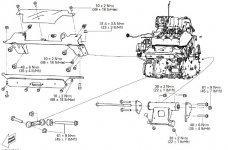h0gr1der
New member
All,
I would like some technical expertise from those of you that have actually turned wrenches on the 1330 Ace.
Here is my dilemma. I'm a complete newb, so pardon my ignorance. I've purchased a new 2018 RTL and found the belt tension high using a Krikit. Read enough and watched enough videos to be confident in setting the tension and alignment. Upon inspection before adjustment, I find the belt is running to the far right at the back, looked like it was touching the flange, while the front was running to the far left, also appearing to touch the flange.
The factory service manual has an alignment section in the engine removal and installation section, but it doesn't say anything about how to align one. They mention a length of 120.1mm for the front rod link, but don't say how that pertains to alignment or if it is just a torque link. Has anyone seen this issue before? If the belt is rubbing a flange will it heat up? After setting the tension to the recommended value, I got the belt to show an occasional gap of a few thousandths of an inch at the back, same at the front. I looked for any articles about how to uncover and inspect the front pulley, and maybe belt replacement, but can't seem to locate any.
I think I can't rely on the dealer, they aren't even courteous enough to return my call about the Kenda tires shaking the whole front of the bike. I think I'm on my own here.
I would like some technical expertise from those of you that have actually turned wrenches on the 1330 Ace.
Here is my dilemma. I'm a complete newb, so pardon my ignorance. I've purchased a new 2018 RTL and found the belt tension high using a Krikit. Read enough and watched enough videos to be confident in setting the tension and alignment. Upon inspection before adjustment, I find the belt is running to the far right at the back, looked like it was touching the flange, while the front was running to the far left, also appearing to touch the flange.
The factory service manual has an alignment section in the engine removal and installation section, but it doesn't say anything about how to align one. They mention a length of 120.1mm for the front rod link, but don't say how that pertains to alignment or if it is just a torque link. Has anyone seen this issue before? If the belt is rubbing a flange will it heat up? After setting the tension to the recommended value, I got the belt to show an occasional gap of a few thousandths of an inch at the back, same at the front. I looked for any articles about how to uncover and inspect the front pulley, and maybe belt replacement, but can't seem to locate any.
I think I can't rely on the dealer, they aren't even courteous enough to return my call about the Kenda tires shaking the whole front of the bike. I think I'm on my own here.

